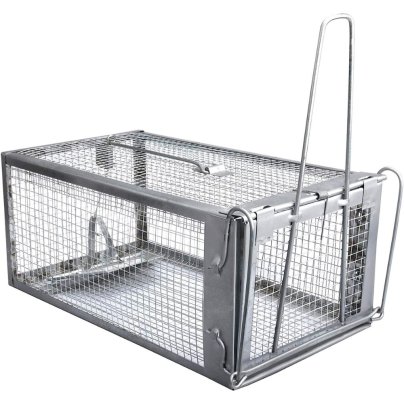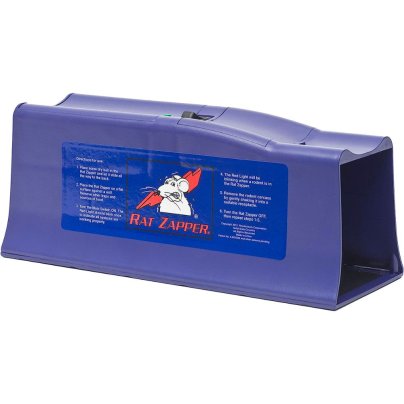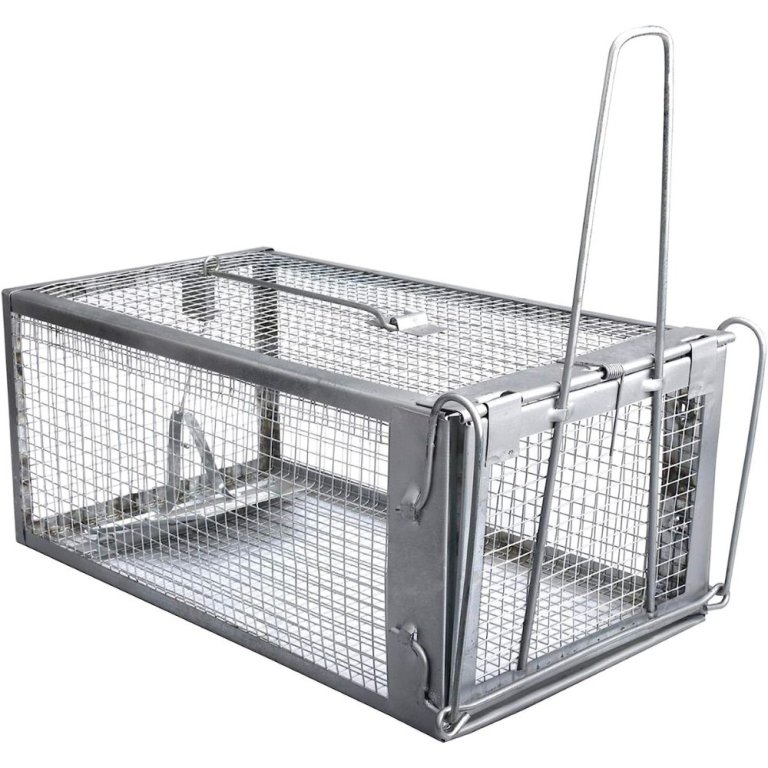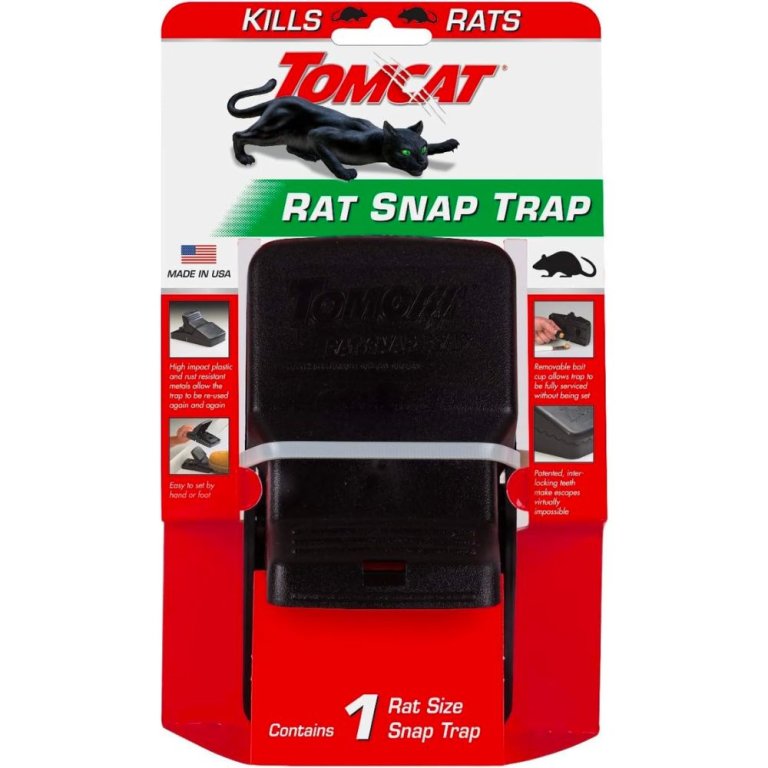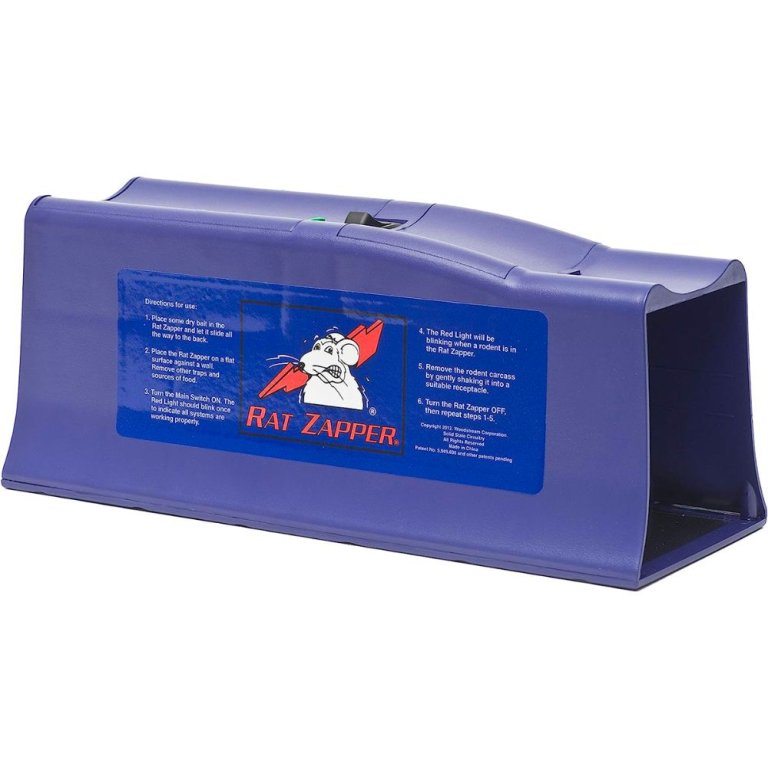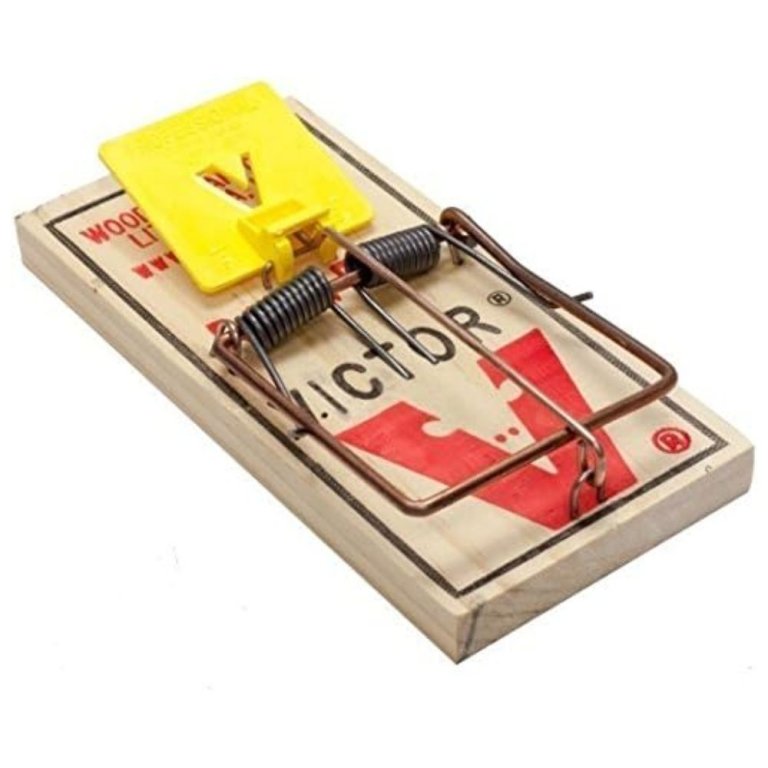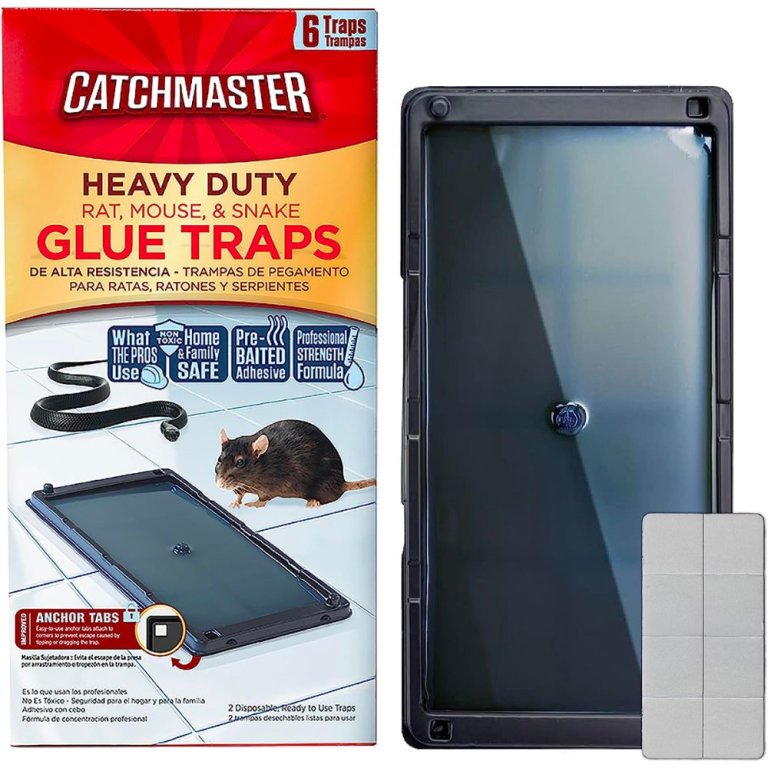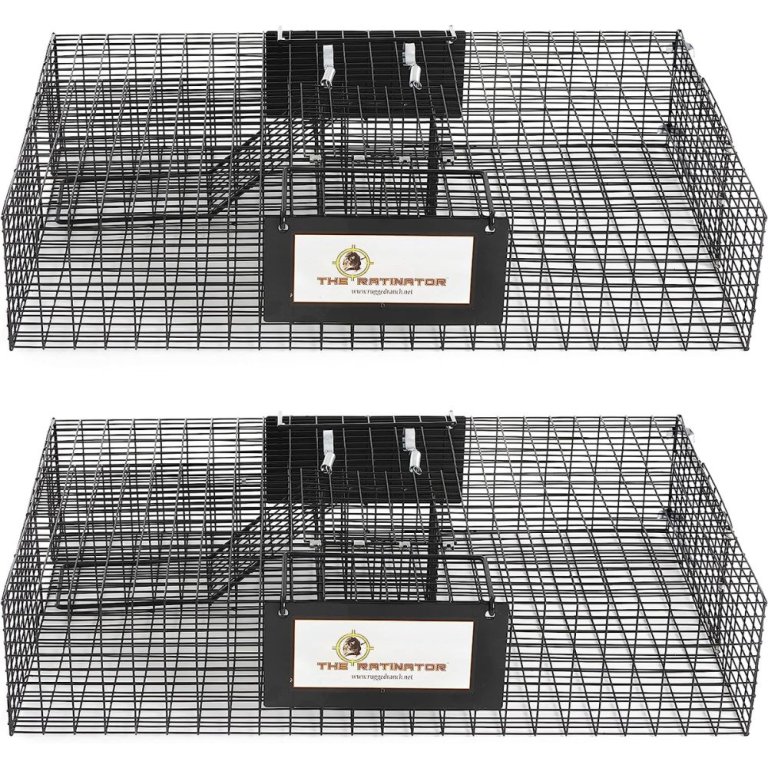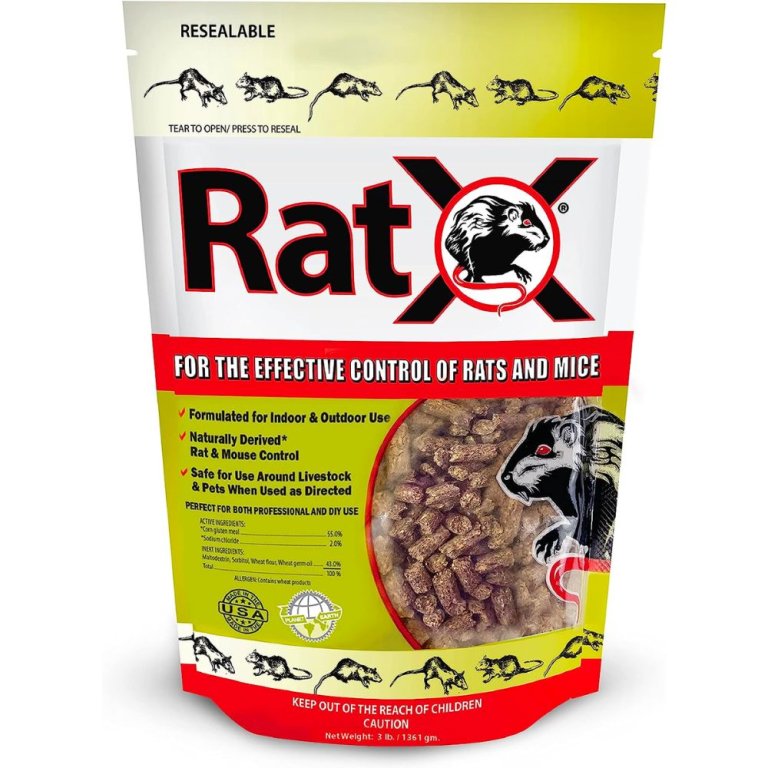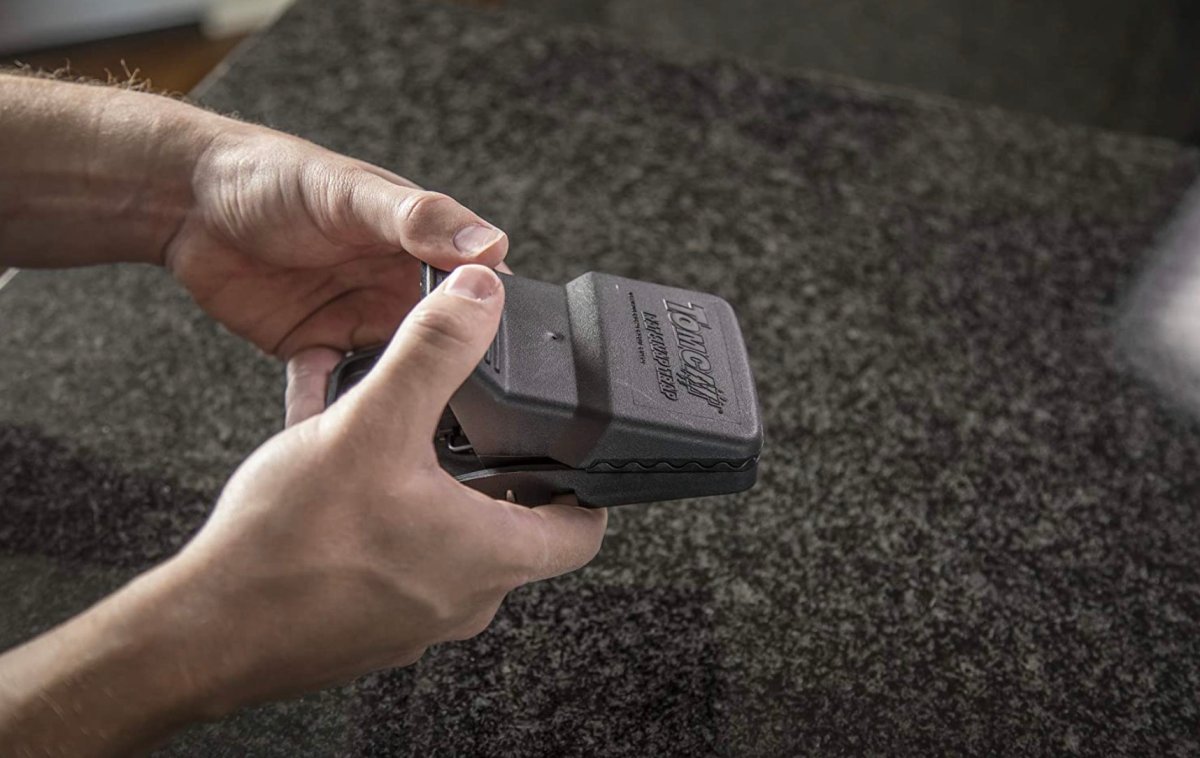
We may earn revenue from the products available on this page and participate in affiliate programs. Learn More ›
If you see tiny droppings in the cupboard and hear scratching noises in the walls, it might be time to start looking at rat traps. According to the U.S. Census, mice and rats invade some 14.8 million U.S. homes each year. These pests infiltrate food supplies, make nests in closets, and expose households to a host of health risks.
With about 1 out of 10 American homes reporting a residential rodent sighting in the past year, the good news is that there are plenty of effective solutions—both lethal and nonlethal—to address the problem. To make choosing the right trap easier, we researched a range of top options and reached out to two pest control experts for advice. Our pick for the best overall rat trap is the Gingbau Humane Rat Trap, thanks to its simple setup, humane design, and easy-to-clean construction.
Read on for our list of the best rat traps available, plus expert-backed guidance on which rodent control methods will best suit your needs and preferences.
- BEST OVERALL: Gingbau Humane Live Rat Trap Cage
↓ Jump to Review - BEST BANG FOR THE BUCK: Tomcat Rat Snap Trap
↓ Jump to Review - BEST ELECTRONIC: Victor Rat Zapper Classic Electronic Rat Trap
↓ Jump to Review - BEST WOODEN: Victor Wide Pedal Rat Trap
↓ Jump to Review - BEST GLUE: Catchmaster Heavy-Duty Rat, Mouse & Insect Glue Traps
↓ Jump to Review - BEST FOR MULTIPLE RATS: Rugged Ranch The Ratinator Multiple Catch Rat Trap
↓ Jump to Review - BEST NONTOXIC BAIT: EcoClear Products RatX Pellets
↓ Jump to Review - BEST KID-SAFE: UCatch SuperSafes Dual-Entry Tunneled Rat Trap
↓ Jump to Review
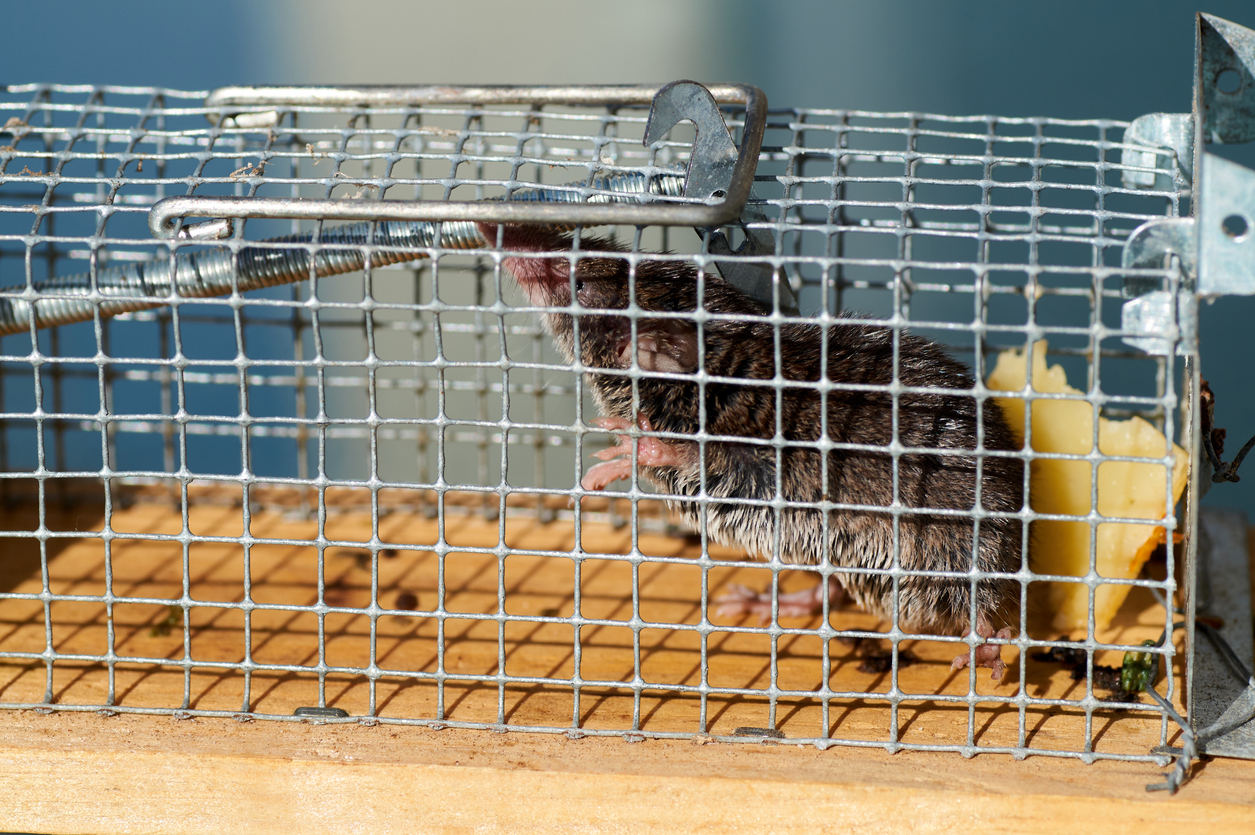
Rat Traps Comparison
| Product | Type | Disposal Method | Reusable |
|---|---|---|---|
| Gingbau Humane Live Rat Trap Cage | Live-animal cage | Catch and release | Yes |
| Tomcat Rat Snap Trap | Snap trap | Manual removal | Yes |
| Victor Rat Zapper Classic Electronic Rat Trap | Electronic trap | Hands-free; hidden from view | Yes |
| Victor Wide Pedal Rat Trap | Snap trap | Manual removal | Yes |
| Catchmaster Heavy-Duty Rat, Mouse & Insect Glue Traps | Glue trap | Manual disposal | No |
| Rugged Ranch The Ratinator Multiple Catch Rat Trap | Live-animal cage | Catch and release | Yes |
| EcoClear Products RatX Pellets | Nontoxic bait | N/A | No |
| UCatch SuperSafes Dual-Entry Tunneled Rat Trap | Snap trap | Manual removal | Yes |
Our Top Picks
Our list of top-performing products addresses typical household rodent problems using both lethal and nonlethal methods, including traps from some of the best-known names in the pest control industry.
Best Overall
Gingbau Humane Live Rat Trap Cage
Buy at AmazonWhat We Like
- Simple setup for humane rat trapping
- Metal build allows for wiping or rinsing
- Lightweight and easy to transport
What We Don’t Like
- Trigger may not engage for smaller rats
Product Specs
- Type: Live-animal cage
- Disposal method: Catch and release
- Reusable: Yes
This cage trap from Gingau allows you to catch rats and mice alive so you can humanely relocate them. Made from sturdy galvanized steel, it’s perfect for outdoor use. At 10.5 inches long, 5.6 inches wide, and 4.4 inches high, it’s sized for rats and mice, but not large enough for bigger animals like cats.
Setup is simple thanks to detailed instructions. The trap features a bait hook at the back and a pressure-sensitive pedal underneath. When a rodent steps inside, the pedal triggers the armbar, causing the door to close and lock automatically. Weighing under a pound, this reusable trap makes relocating rodents easy and eco-friendly.
Get the Gingbau rat trap at Amazon.
Best Bang for the Buck
Photo: AmazonWhat We Like
- Reusable for household pest control or professional use
- Effective snap closure kills instantly
- Removable bait cup for easy setup
What We Don’t Like
- Requires manual disposal of the animal or entire trap
Product Specs
- Type: Snap trap
- Disposal method: Manual removal
- Reusable: Yes
For outdoor use, you often need a trap that can handle more than just mice. This snap trap from rat-catching specialist Tomcat is a safe and easy-to-use indoor/outdoor trap designed to handle rats. Measuring 6 inches long, 4.25 inches wide, and 2 inches high, this snap trap is big enough for larger rodents. It also comes with a removable bait cup that makes setup easy.
The innovative snap-jaw design springs shut when a rat takes the bait, dispatching it quickly and humanely. Unlike traditional wooden traps, you can set these plastic traps using your foot rather than risking your fingers. The rust-resistant metal and plastic construction is also easier to clean and maintain than wood, making this trap a convenient upgrade for rodent control.
Get the Tomcat rat trap at Amazon, Lowe’s, Tractor Supply Co., Ace Hardware, The Home Depot, Walmart, Blain’s Farm & Fleet, or Tomcat.
Best Electronic
Photo: AmazonWhat We Like
- Considered a more humane method of getting rid of rats
- Dead rats is hidden from view; ideal for homes with pets or children running around
- User can dispose of rats without touching them for safety
What We Don’t Like
- May be difficult to clean inside the trap after use
Product Specs
- Type: Electronic trap
- Disposal method: Hands-free; hidden from view
- Reusable: Yes
The Rat Zapper Classic makes rodent control simple and sanitary. This tunnel-shaped electronic trap is 12 inches long, 4.5 inches wide, and 4.3 inches high—roomy for mice and average-size rats. When a rat or mouse enters the tunnel and steps onto the metal plates, it completes an electric circuit that sends a high-voltage shock through its body for a quick and humane end.
Powered by four AA batteries (enough for up to 20 rat kills), the Rat Zapper automatic rat trap has a convenient LED light that flashes green to indicate a successful catch and red when battery power is low. Cleanup is easy and touch-free: just tilt the trap to empty it without having to see or handle the rodent. As an electric rat trap, it’s suitable for indoor use only.
Get the Victor Rat Zapper rat trap at Walmart, Ace Hardware, Amazon, or Victor.
Best Wooden
Photo: AmazonWhat We Like
- 2 settings: firm and sensitive
- Wood sourced from Forest Stewardship Council (FSC)–certified forests
- Can be reused or thrown away after a catch
What We Don’t Like
- May not be safe for homes with children and pets
Product Specs
- Type: Snap trap
- Disposal method: Manual removal
- Reusable: Yes
While wooden rat traps might seem a bit old-fashioned, these Victor rat traps remain a proven and effective solution. Their wide pedals are designed to snap closed quickly with the slightest pressure, increasing the chances of a catch. With adjustable settings for firm or sensitive triggering, users can tailor these wooden traps to their preference for rodent control.
Made in the U.S. from FSC-certified wood, these rat traps support environmentally friendly forestry. They’re available as multi-packs of various quantities to accommodate the size of your property or the degree of rat activity you’re dealing with. Although these wooden traps are non-toxic and free from chemicals, be sure to place them out of reach of kids and pets.
Get the Victor Wide Pedal rat trap (various pack sizes) at Amazon or The Home Depot.
Best Glue
Catchmaster Heavy-Duty Rat, Mouse, & Insect Glue Traps
Buy at Amazon Buy at Ace Hardware Buy at The Home DepotWhat We Like
- Available in various pack counts
- Effective up to 1 year
- Comes with floor anchors
What We Don’t Like
- Not reusable; manual disposal required
Product Specs
- Type: Glue trap
- Disposal method: Manual disposal
- Reusable: No
These sticky traps for rats from Catchmaster include glue-style trays that are nontoxic and safe for use around children and pets. The powerful adhesive instantly traps rodents, insects, or snakes that cross the board, providing an effective pest control solution without the need for additional bait. Each pack includes multiple boards that remain effective for up to 1 year, allowing long-term control of a rodent population without financial strain.
The Catchmaster glue traps can fold into a tunnel shape, allowing them to fit into tight places and prevent dust and dirt from collecting in the glue. They also come with anchors and heavy-duty putty that ensures rodents can’t drag them away and free themselves. Measuring about 10 inches long, 5 inches wide, and 0.5 inches thick, each rat sticky trap is suitable for indoor or sheltered outdoor use.
Get the Catchmaster rat trap (various pack sizes) at Amazon, Ace Hardware, The Home Depot, Walmart, or Catchmaster.
Best For Multiple Rats
Rugged Ranch The Ratinator Multiple Catch Rat Trap
Buy at Amazon Buy at Tractor Supply Co. Buy at WalmartWhat We Like
- Can hold 21 rats at a time
- Suitable for household and professional pest control
- Multiple hatches to release rats after catching
What We Don’t Like
- Spring mechanism can weaken over time
Product Specs
- Type: Live-animal cage
- Disposal method: Catch and release
- Reusable: Yes
When dealing with a rat infestation, standard rat traps that only catch one rodent at a time just won’t do. The Ratinator, by Rugged Ranch, is a larger, cage-style multi-catch trap designed to hold up to 21 rats in a single setting. Measuring approximately 25 inches long, 16.5 inches wide, and 6 inches high, it offers ample space for humane capture.
This nonlethal live trap weighs just under 9 pounds empty and is equipped with a double-door design that attracts and traps rodents efficiently. Similar to a bucket rat trap, this cage comes with an airtight plastic container for secure transport far away from homes. The Ratinator is suitable for indoor or outdoor use and an excellent choice for substantial rodent problems.
Get the Rugged Ranch rat trap (various pack sizes) at Amazon, Tractor Supply Co., Walmart, or Target.
Best Nontoxic Bait
Photo: AmazonWhat We Like
- Safe around pets (except gerbils) and children
- Comes in various sizes for large and small infestations
- Causes rats to die within 2 to 4 days of ingestion
What We Don’t Like
- Rats are not always attracted to the bait
- Not for homes with pet mice, rats, or gerbils
Product Specs
- Type: Nontoxic poison bait
- Disposal method: N/A
- Reusable: No
For households with young children or pets, using poisonous bait isn’t a safe option for solving a mouse or rat problem. Made with active ingredients corn gluten meal and sodium chloride (table salt), this nontoxic bait from EcoClearit takes advantage of rodents’ unique digestive systems to disrupt their instinct to drink water, causing them to die of dehydration within 2 to 4 days.
RatX rat bait comes in pellet form, allowing users to add it to bait trays for indoor or outdoor use. It’s available in a range of quantities for mouse or rat problems of various sizes. Because RatX is nontoxic to people, pets, and wildlife when used as directed, it’s a good choice for those concerned about safety and environmental impact.
Get the EcoClear Products rat pellets (various sizes) at Amazon, Ace Hardware, The Home Depot, or Walmart.
Best Kid-Safe
UCatch SuperSafes Dual-Entry Tunneled Rat Trap
Buy at AmazonWhat We Like
- Dual-entry design is ideal for use in tight spaces
- Covered tunnel protects kids and pets from jaws and bait
- Integrated lever allows for easy setup and disposal
What We Don’t Like
- May not withstand extended outdoor use
Product Specs
- Type: Snap trap
- Disposal method: Manual removal
- Reusable: Yes
Children and pets running around the house is fun and wholesome, but rats running around with them can be hazardous. The UCatch SuperSafes rat trap is designed to keep everyone safe while effectively controlling pests. Its dual-entry covered tunnel design conceals the snap trap jaws and bait cup, preventing accidental contact by little hands or paws, while allowing rats easy access inside.
Built with a precision trigger and strong steel spring, this trap dispatches rodents quickly and humanely on contact. The integrated lever makes setting the trap and disposing of a dead rodent clean and hands-free: Simply push the lever down to release the body and reset for reuse. Made from durable ABS plastic, this trap is suitable for both indoor and outdoor use.
Get the UCatch rat trap at Amazon.
Jump to Our Top Picks
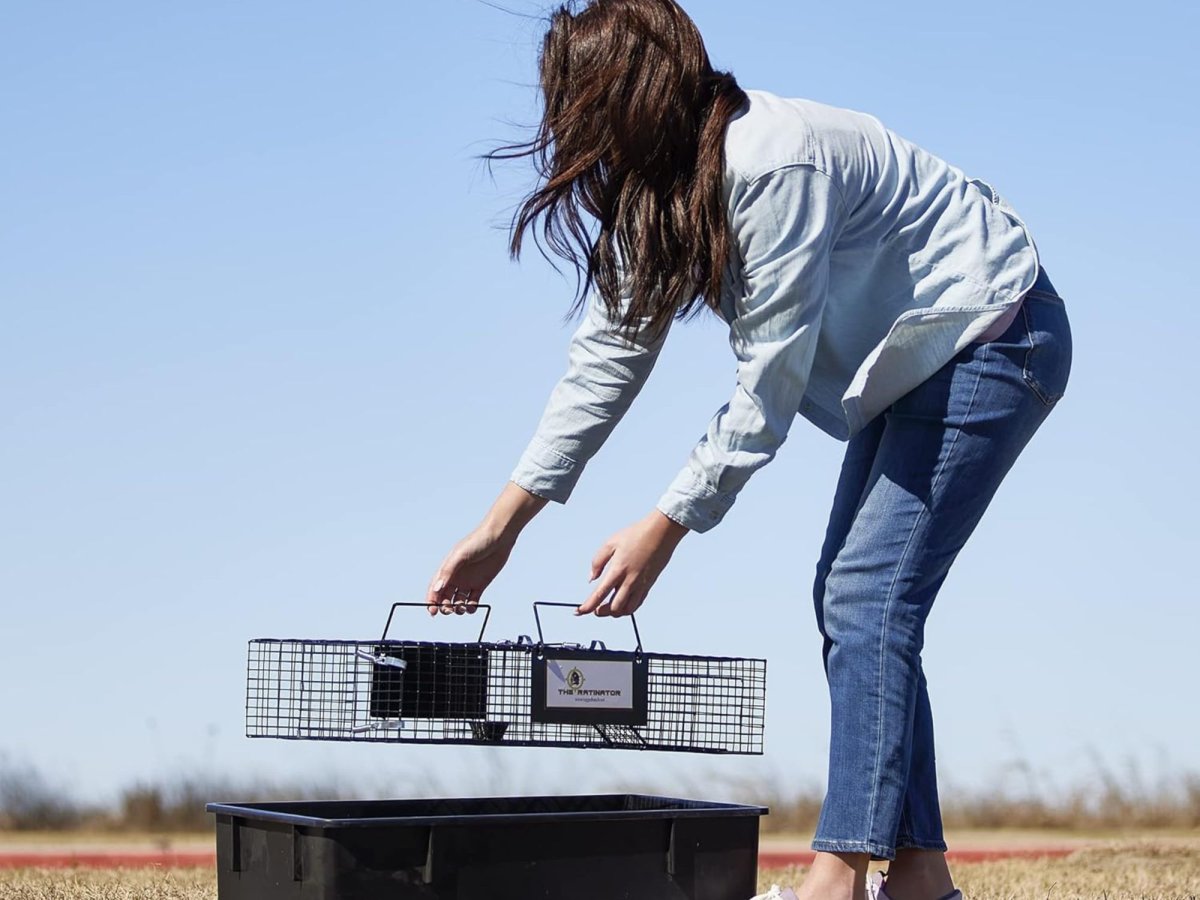
How We Chose the Best Rat Traps
To help choose the best rat traps for our guide, we reached out to pest control experts to get their professional advice. Tim Sherrer, owner of Expest Exterminating in Athens, Georgia, says, “Identification of the type of rat or rodent is very important when considering control options.” Sherrer points out that larger rats typically require heavy-duty snap traps as glue boards may not be strong enough to hold them.
With this in mind, our curated list of top picks includes all major trap types: glue, snap, catch-and-release, bait, and electronic traps and zappers. We included solutions for various infestation sizes, as well as options for those seeking more humane methods. Since disposing of dead rats is certainly not a job for everyone, we highlighted several traps that conceal the rodent and allow for touch-free disposal.
What to Consider When Choosing a Rat Trap
When selecting the best interior and exterior rat traps to get rid of rats, it’s crucial to consider where it will be used, the size of the rodent population, and whether the goal is to catch or kill these four-legged intruders.
Types of Rat Traps
Below, learn about four basic varieties of rat traps—snap, glue, live animal, and electronic—to determine which type will work best for your rodent problem.
Snap Trap
This is the old-school rat trap that consists of a thick metal wire mounted on a small piece of wood. It uses a spring-and-catch design mechanism that’s set by placing bait on a metal trigger. When the rat takes the bait, the catch releases and the metal bar snaps down on the rat’s neck, killing it instantly.
While these traps are cheap and effective, they are also potentially dangerous. Depending on the trap’s size, it can hurt (or even break) fingers, making them unsuitable for homes with young children.
Plastic snap traps are a safer alternative, as they kill by suffocation rather than force. Their design resembles the open mouth of a snake, and when a rat wanders into these plastic jaws and takes the bait, it clamps shut. The closing mechanism isn’t strong enough to injure fingers or toes, and plastic traps are also reusable, though they typically cost more than wooden snap traps for rats.
Glue Trap
Glue traps are one of the most effective yet controversial ways of catching a rat. A glue trap consists of a flat plastic board covered in extremely sticky glue on one side. To use, simply place these traps in an area with activity, and when an animal moves across them, it will become stuck and immobilized. The more it struggles, the more trapped it becomes.
These traps are not an ideal solution, since most people consider them inhumane. Rather than killing the animal immediately, they cause slow death from dehydration or starvation. Glue traps also cannot be reused and tend to collect dust, dirt, and even insects, eventually rendering them ineffective.
Live-Animal Trap
Cage-style live-animal traps for rats are a nonlethal option and the most humane way to handle a rat problem. Bait is used to lure the rat into the cage, where it steps on a pressure-sensitive trip plate. This triggers a spring mechanism that snaps the door shut, trapping the rat inside.
Once captured, the rat can be safely relocated, which typically requires a car trip to release it far enough away that it won’t return. While effective, live traps are often larger and more expensive than other options, and they may occasionally catch other small animals by accident.
Electronic Trap
This more humane form of lethal rat trap uses a high-voltage shock to kill rats instantly. These tunnel-shaped traps include one or more bait traps along their back wall to lure the rat inside. When the rat steps on the metal plate at the base, the trap detects pressure and delivers a powerful electric charge to dispose of it.
Electric rat traps typically run on multiple batteries, making them better for indoor use than outdoor. Since their shock isn’t strong enough to harm children or larger pets like dogs and cats, they are safe around people and most pets.
Indoor vs. Outdoor
Some traps are designed for only indoor or outdoor use:
- Traditional snap traps do not fare well outside because of their wooden construction. If left to weather, the wood can warp, ruining the trap’s trigger sensitivity.
- Due to their propensity to collect dirt and debris, glue traps are only suitable for indoor use. Electronic rat traps are not weather-resistant. Exposure to rain could cause them to short out or malfunction.
- Cage traps, which typically feature galvanized steel, are suitable for outdoor use. It’s important to keep in mind that wildlife and neighborhood pets may inadvertently be affected by outdoor traps.
- Newer plastic snap traps can withstand outdoor weathering, making them good outdoor rat traps.
Kill vs. Catch-and-Release Traps
Those who believe killing these rodents is inhumane can consider a catch-and-release option. Just keep in mind that catch-and-release traps require the extra step of transporting the animal to another location so it does not return. However, it’s possible to inadvertently release that rat on someone else’s property, which presents a whole other ethical dilemma.
Nicole Carpenter, president of Black Pest Prevention, shared her expert advice on how to use a cage trap effectively: “Place a cage or live catch trap in the areas near your home where you have noticed rat activity and monitor it. When there’s a rat in the trap, you need to release it far from your home, ideally well away from your neighborhood.” She adds that to be as humane as possible, these traps also require “regular monitoring to avoid causing stress and harm to the captured rat.”
Number of Traps
Ridding a home of its rat or mouse population can be a frustrating process. Although many of these traps have been around for decades, they don’t always work.
One problem may be the number of traps being used. Pest companies recommend three rat or mouse traps for every rodent. If there are five rodents inhabiting a home, that means 15 traps will be needed to put an end to the infestation.
Single vs. Multi-Rat Trap
Single traps work well for handling smaller problems of fewer than 10 mice. Just remember that most experts recommend three single traps per rodent to get rid of mice or rats.
Multi-rat traps, such as the famous Kness Ketch rat trap invented 100 years ago, can catch up to 15 mice in one setting—meaning you may only need to set this trap once to keep rats from destroying your home.
These nonlethal traps are generally only used in commercial locations or homes with more significant mouse and rat problems. Since they require users to dispose of live animals once trapped, mautli-rat traps are often only used by pros familiar with the process.
Disposal Method
Disposing of rat corpses can be understandably unpleasant. For example, the classic snap trap requires a user to manually remove the corpse in order to reuse the trap. Glue traps make disposal easier—all the user needs to do is simply pick up the whole trap and throw it away. However, this disposable design requires replacing the trap with a new one after every kill, which can get costly if there’s a large rat population.
Some newer designs allow the user to dispose of the rat without having to touch the dead rodent or even look at the corpse. These traps kill the rat in an enclosed space and use an external indicator to let the user know when it’s full. To dispose of the body, simply tip the trap over the garbage. This is a more attractive option for the faint of heart and still allows reuse of the trap.
Safety
Safety is undoubtedly an issue when it comes to rat traps. If there are children or pets in the home, this aspect is especially important when shopping for a rat trap.
The classic snap-style traps can be dangerous, and users should take care with their rat-trap placement. Smaller traps can painfully snap fingers, while larger traps can break bones.
Some use poison bait to kill rats, which is toxic to humans and pets. Glue traps, electric shock traps, and nontoxic bait offer safer alternatives.
Ease of Use
Some traps are easier to set and use than others. The classic snap trap requires some skill to set properly and to ensure users don’t snap themselves. Plastic snap traps and electric traps feature designs that make them much easier to set, while glue traps simply require removing a protective cover for use.
FAQs
If you still have gnawing questions about repelling rats, read on for answers to some of the most common questions about when and how to use the best rat traps. evolved in rodents. They will avoid objects new to their environment until enough time has passed that these items become familiar. This is why it may take some time before the traps you just put out begin to bear fruit.
Since rats and mice are not particularly hygienic creatures, there are many signs that indicate an infestation:
– Droppings and urine are present. Since mice and rats aren’t the cleanest of houseguests, rat droppings and urine stains are sure signs of rodents in your home. The more droppings you see, the more mice or rats there are.
– You see gnawed holes on things like baseboards, wood trim, cabinet doors, and packaged foods. Rats and mice will chew through all kinds of materials to get to food. If you find gnawed holes in areas throughout your home, you likely have a rodent problem.
– You hear sounds in the walls and ceilings. If you hear scampering noises in your walls or ceiling, you likely have mice.
– Your pet is displaying odd behavior. Your pets and their heightened sense of hearing and smell will pick up on these rodent visitors before you do. If Fido or Fluffy seems to be hearing or seeing things you don’t, it could be mice or rats.
Rats spend most of their lives hunting down the next meal, and humans are a great source of food. The first thing they’ll detect is your garbage. From there, they’ll move to other food smells coming from inside your home. Nip things in the bud by preventing rats from getting into your garbage. Make sure your garbage cans have tight lids.
Rats are inherently suspicious creatures; it’s a survival mechanism that has evolved in rodents. They will avoid objects new to their environment until enough time has passed that these items become familiar. This is why it may take some time before the traps you just put out begin to bear fruit.
Many people think poison will kill rodents quickly. Rat poison is one of the slowest methods for killing them, as it takes at least 3 days for it to kill the rodent once it’s ingested. Snap traps will break a rat’s neck, and electric traps, which deal a lethal shock to rodents, will instantly kill rats.
According to Nicole Carpenter, president of Black Pest Prevention, “Not only doesn’t a dead rat repel other rats, but it attracts them and other pests like flies and ants. A dead rat will only make other rats come and explore, and even learn to avoid traps—but not entirely leave. Rats are smart enough and can quickly figure out what’s dangerous and what to avoid, especially if they’ve seen one of their own die nearby.”
Pest control expert Nicole Carpenter says that “The best baits are those that are both enticing and require some effort to remove, like peanut butter, soft cheese, or a small piece of hot dog, which will stick to the trigger plate, making it more likely to activate when eaten. Ensure the bait is securely attached so that rats can’t nibble it off without springing the trap.”
Carpenter says rats generally stay within 10 to 30 feet of their nest or food source and move alongside hard surfaces rather than across open spaces. “If you place bait in those tight, shadowy routes along walls or behind objects, they’re much more likely to run into it. If you’ve got rats outdoors, don’t just toss bait in the middle of the yard—place it along fences, shed walls, behind trash bins, under decks, or the foundation of your house.”
“More traps in more spots means a better chance of getting them before they know there’s something up and start avoiding them. If you’ve only seen a rat once or found fresh droppings in just one area, set at least five to six traps in that specific zone—space them about 4 feet apart along the walls. If you’ve heard activity in multiple rooms or see droppings in more than one spot, you need around 10 to 12 traps total, with three to four in each active area,” says Carpenter.
